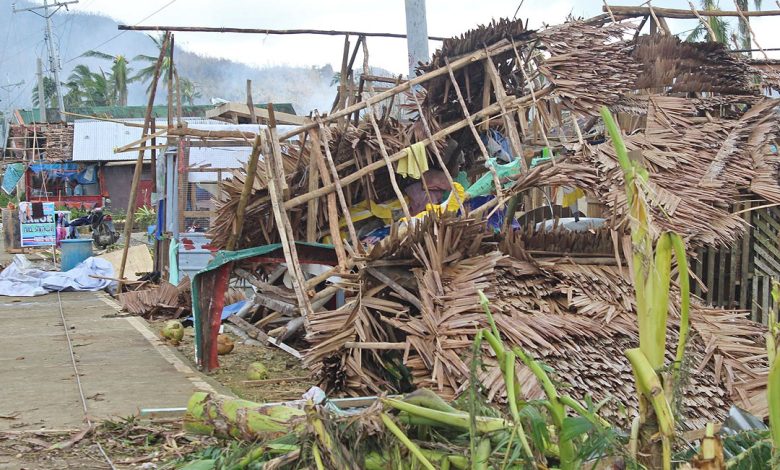Government urged to be transparent over funds in ‘Odette’ aftermath

HOUSES were destroyed by Typhoon Rai (Odette) are seen in Surigao del Norte in this photo taken by the Philippine Coast Guard Civil Relations Service, Dec. 18. — PHILIPPINE COAST GUARD FACEBOOK PAGE
By Kyle Aristophere T. Atienza, Reporter
ANALYSTS and development workers urged the Philippine government to disclose the status of its three special purpose funds that could be used for calamity response programs, as one of the world’s strongest storms of the year left many parts of the country devastated.
They made the call after President Rodrigo R. Duterte said the government is trying to raise money for relief measures since the public coffers were depleted due to pandemic spending.
“At the peak of COVID, the government really pooled all its resources, there’s hardly no spending limit. But we didn’t expect that this (typhoon) would happen now,” he said in a public briefing in Maasin, Leyte on Saturday. A transcript was made available by his office on Sunday.
“So this is what I said last night: We’re trying to scrape whatever we can from the savings of the government. There’s a little money left so I can help you. Help will arrive here,” he added.
Mr. Duterte’s statement reflects “a lack of understanding of his government’s national budget and failure to consult the Budget department before speaking about it,” said Zy-za Nadine Suzara, executive director of the public finance think-tank, Institute for Leadership, Empowerment, and Democracy (I-LEAD).
In a Viber message, Ms. Suzara said it is “irresponsible” to say the budget was depleted by pandemic spending and to suggest that nothing can be immediately tapped in the aftermath of Typhoon Rai, locally known as Odette, because “every national budget contains funds for disaster relief and rehabilitation.”
Ms. Suzara said “knowing which parts of the budget can immediately be tapped is necessary in dealing with the large-scale devastation wrought by Typhoon Odette.”
She noted as of end-November, there is a total available balance of P6.5 billion from the government’s 2020 and 2021 national disaster risk reduction and management funds, which can be released upon the approval of the President.
Ms. Suzara said there are also quick response funds under the budget of frontline agencies such as the Department of Social Welfare and Development, Department of Health, Department of Agriculture, among others.
“A third option is the President’s Contingent Fund — another special purpose fund that can be used, as its name suggests, for contingencies,” she added. “Those are programmed appropriations that the Treasury will have to finance.”
While local governments have disaster funds that can also be immediately tapped, the National Government needs to step in considering the extent of the destruction, Ms. Suzara said.
“President Duterte’s statement was insensitive at the very least and ill-informed at worst, especially for an office which has so much resources and from which so much is expected,” Sonny A. Africa, executive director of think tank Ibon Foundation, said in a Facebook Messenger chat.
Mr. Africa said the National Government’s calamity fund has averaged just P18.6 billion annually over the 2017-2022 period, nearly half of the P38.9 billion budget in 2016 or the last budget of the Aquino administration.
“The budget was not even wholly used up in 2020 and some P5.1 billion carried over for a total of P25.1 billion at the start of 2021… We suspect that much still remains because of the economic managers’ proven stinginess on relief measures,” he said.
Mr. Africa said the government “does not seem cash-strapped at all” because in the first 10 months of the year, it has had P2.5 trillion in revenues and borrowed P2.8 trillion. “It has only spent P4 trillion so far and so still has some P1.3 trillion in cash.”
“If the president chose to, he can use balances from his P4.5 billion in confidential and intelligence funds or P13 billion contingent fund, both directly under his control,” he said.
IBON estimated the destruction brought by Typhoon Odette would likely take its toll on the national economy, which is still recovering from the pandemic.
Government reports showed that more than 70 people died as of Dec. 19 from the recent typhoon, which destroyed thousands of homes in southern and central parts of the country.
“It is the government’s mandate to make sure enough funds are allocated should emergencies like Typhoon Odette happen,” a representative from the Citizens’ Disaster Response Center (CDRC) said in a Facebook Messenger chat, noting that the country should have the budget to mitigate Typhoon Odette’s impacts even while managing the pandemic because it is a fact that the country is visited by an average of 20 typhoons yearly.
“The government should be quick to carry out activities to arrest further deterioration of life and property, and remove affected families from life threatening situations,” it said. “This is why it is necessary for the government to immediately release funds and aid to people affected by Typhoon Odette.”
A community-based disaster response organization in Leyte said at least 300 houses were totally destroyed in four towns in the southern part of the province. “These were the horrors that awaited us: 24 deaths and many more missing. The count continues to rise.”
The Leyte Center for Development, Inc., which is part of CDRC’s network of disaster response groups nationwide, said several villages in the province experienced storm surges as high as 12 feet, resulting in a “gargantuan devastation to livelihoods and properties.”
“The people told us no regional nor provincial government agency has checked on them,” Executive Director Minet Aguisanda said in a Facebook Messenger chat. “They need food, shelter materials and livelihood support.”
The CDRC urged presidential candidates to prioritize disaster risk reduction and management in their electoral agenda. “We challenge them to come up with platforms not only to effectively respond to disasters, but most importantly, to build the capacities of communities to prevent or prepare for calamities, and address the root causes of people’s vulnerability to disasters.”
Mr. Africa of IBON said the government should “embrace civil society and mass media as partners in governance rather than, as present, enemies to be shut down.”
“There is no doubt that the development sector and civic groups will mobilize to provide aid as swiftly as they could, but the National Government has to take the lead and coordinate those emergency relief efforts done by different groups,” Ms. Suzara of I-LEAD said. “That means the National Government should have a clear recovery plan and strategy.”
She said the administration must be transparent about which funds are available for relief and recovery programs. “They should also be transparent about the amounts and status of foreign aid and donations coursed through National Government agencies.”
“Later on, the National Government also needs to come up and present a concrete plan for recovery and rehabilitation later on. Malacañang also needs to show how exactly those programs will be funded,” Ms. Suzara said.




